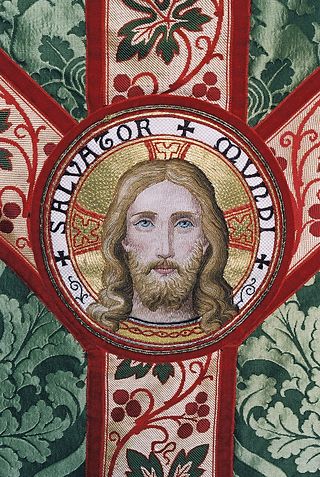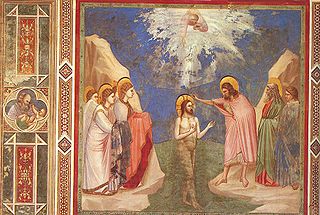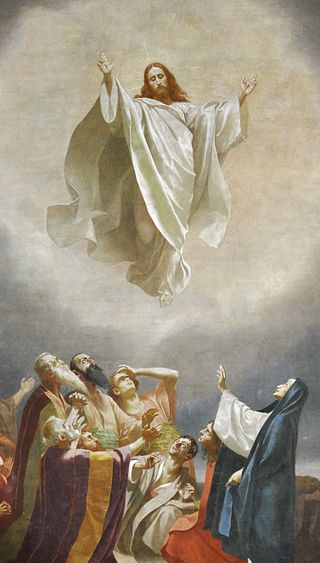Related Research Articles

The liturgical year, also called the church year, Christian year, ecclesiastical calendar, or kalendar, consists of the cycle of liturgical days and seasons that determines when feast days, including celebrations of saints, are to be observed, and which portions of scripture are to be read.

Advent is a season observed in most Christian denominations as a time of expectant waiting and preparation for both the celebration of the Nativity of Christ at Christmas and the return of Christ at the Second Coming. Advent is the beginning of the liturgical year in Western Christianity. The name was adopted from Latin adventus "coming; arrival", translating Greek parousia from the New Testament, originally referring to the Second Coming.

Liturgical colours are specific colours used for vestments and hangings within the context of Christian liturgy. The symbolism of violet, blue, white, green, red, gold, black, rose and other colours may serve to underline moods appropriate to a season of the liturgical year or may highlight a special occasion.

The Advent wreath, or Advent crown, is a Christian tradition that symbolizes the passage of the four weeks of Advent in the liturgical calendar of the Western church. It is traditionally a Lutheran practice, although it has spread to many other Christian denominations.

Ordinary Time is the part of the liturgical year in the liturgy of the Roman Rite, which falls outside the two great seasons of Christmastide and Eastertide, or their respective preparatory seasons of Advent and Lent. Ordinary Time thus includes the days between Christmastide and Lent, and between Eastertide and Advent. The liturgical color assigned to Ordinary Time is green. The last Sunday of Ordinary Time is the Solemnity of Christ the King.

Trinity Sunday is the first Sunday after Pentecost in the Western Christian liturgical calendar, and the Sunday of Pentecost in Eastern Christianity. Trinity Sunday celebrates the Christian doctrine of the Trinity, the three Persons of God: the Father, the Son, and the Holy Spirit.

Septuagesima is the name for the ninth Sunday before Easter, the third before Ash Wednesday. The term is sometimes applied to the seventy days starting on Septuagesima Sunday and ending on the Saturday after Easter. Alternatively, the term is sometimes applied also to the period sometimes called pre-Lent that begins on this day and ends on Shrove Tuesday, the day before Ash Wednesday, when Lent begins.

The Paschal Triduum or Easter Triduum, Holy Triduum, or the Three Days, is the period of three days that begins with the liturgy on the evening of Maundy Thursday, reaches its high point in the Easter Vigil, and closes with evening prayer on Easter Sunday. It is a moveable observance recalling the Passion, Crucifixion, Death, burial, and Resurrection of Jesus, as portrayed in the canonical Gospels.

The Feast of the Baptism of the Lord, or Theophany, is the feast day commemorating the baptism of Jesus in the Jordan River by John the Baptist. Originally the baptism of Christ was celebrated on Epiphany, which commemorates the coming of the Magi, the baptism of Christ, and the wedding at Cana. Over time in the West, however, the celebration of the baptism of the Lord came to be commemorated as a distinct feast from Epiphany. It is celebrated in the Catholic Church as well as the Anglican and Lutheran Churches on the first Sunday following The Epiphany of Our Lord. Some Lutheran churches celebrate it on the Sunday before Lent, or Quinquagesima.

The Feast of the Ascension of Jesus Christ commemorates the Christian belief of the bodily Ascension of Jesus into Heaven. It is one of the ecumenical feasts of Christian churches, ranking with the feasts of the Passion and Pentecost. Following the account of Acts 1:3 that the risen Jesus appeared for 40 days prior to his Ascension, Ascension Day is traditionally celebrated on a Thursday, the fortieth day of Easter according to inclusive counting, although some Christian denominations have moved the observance to the following Sunday, sometimes called Ascension Sunday. The day of observance varies by ecclesiastical province in many Christian denominations, as with Methodists and Catholics, for example.

The Solemnity of Our Lord Jesus Christ, King of the Universe, commonly referred to as the Feast of Christ the King, Christ the King Sunday or Reign of Christ Sunday, is a feast in the liturgical year which emphasises the true kingship of Christ. The feast is a relatively recent addition to the liturgical calendar, instituted in 1925 by Pope Pius XI for the Roman Rite of the Catholic Church. In 1970, its Roman Rite observance was moved from October to the last Sunday of Ordinary Time and thus to the end of the liturgical year. The earliest date on which the Feast of Christ the King can occur is 20 November and the latest is 26 November. It typically marks the end of Ordinary Time, which continues up until Advent Sunday, the first day of Advent. Depending on the year, Saint Andrew's Day, significant in some cultures, may fall prior to Advent Sunday. Thus, Christ the King is typically the last or second-to-last calendrical feast of the liturgical year.
Christian liturgy is a pattern for worship used by a Christian congregation or denomination on a regular basis. The term liturgy comes from Greek and means "public work". Within Christianity, liturgies descending from the same region, denomination, or culture are described as ritual families.

A lectionary is a book or listing that contains a collection of scripture readings appointed for Christian or Jewish worship on a given day or occasion. There are sub-types such as a "gospel lectionary" or evangeliary, and an epistolary with the readings from the New Testament Epistles.
The Revised Common Lectionary (RCL) is a lectionary of readings or pericopes from the Bible for use in Christian worship, making provision for the liturgical year with its pattern of observances of festivals and seasons. It was preceded by the Common Lectionary, assembled in 1983, itself preceded by the COCU Lectionary, published in 1974 by the Consultation on Church Union (COCU). This lectionary was derived from various Protestant lectionaries in current use, which in turn were based on the 1969 Ordo Lectionum Missae, a three-year lectionary produced by the Roman Catholic Church following the reforms of the Second Vatican Council.

The Feast of the Transfiguration is celebrated by various Christian communities in honor of the transfiguration of Jesus. The origins of the feast are less than certain and may have derived from the dedication of three basilicas on Mount Tabor. The feast was present in various forms by the 9th century, and in the Western Church was made a universal feast celebrated on 6 August by Pope Callixtus III to commemorate the raising of the siege of Belgrade (1456).

The Epiphany season, also known as Epiphanytide or the time of Sundays after Epiphany, is a liturgical period, celebrated by many Christian Churches, which immediately follows the Christmas season. It begins on Epiphany Day, and ends at various points as defined by those denominations. The typical liturgical color for the day of Epiphany is white, and the typical color for Epiphany season is green.
The Lutheran liturgical calendar is a listing which details the primary annual festivals and events that are celebrated liturgically by various Lutheran churches. The calendars of the Evangelical Lutheran Church in America (ELCA) and the Evangelical Lutheran Church in Canada (ELCIC) are from the 1978 Lutheran Book of Worship and the calendar of the Lutheran Church–Missouri Synod (LCMS) and the Lutheran Church–Canada (LCC) use the Lutheran Book of Worship and the 1982 Lutheran Worship. Elements unique to the ELCA have been updated from the Lutheran Book of Worship to reflect changes resulting from the publication of Evangelical Lutheran Worship in 2006. The elements of the calendar unique to the LCMS have also been updated from Lutheran Worship and the Lutheran Book of Worship to reflect the 2006 publication of the Lutheran Service Book.

A liturgical book, or service book, is a book published by the authority of a church body that contains the text and directions for the liturgy of its official religious services.

Pentecost season, also known Pentecostide, as well as the time of Sundays after Pentecost or Sundays after Trinity, is a liturgical period, celebrated by some Christian churches, which immediately follows the Easter season. Although the start and end dates vary by liturgical tradition, the season typically begins on the day of Pentecost and continues throughout the rest of the liturgical year, ending just before the season of Advent. The liturgical color for this period is typically green or red.
References
- 1 2 3 Various (2016). "Season After Pentecost (Ordinary Time)". The United Methodist Book of Worship. Nashville, Tenn. ISBN 978-1426735004.
{{cite book}}: CS1 maint: location missing publisher (link) - ↑ United Methodist Church, Whatever Happened to Kingdomtide?, published July 2014, accessed 20 August 2023
- ↑ Pope Pius XI (11 December 1925). "Quas primas". Libreria Editrice Vaticana. Retrieved 3 November 2021.
- ↑ United Methodist Church, Whatever Happened to Kingdomtide?, published July 2014, accessed 20 August 2023
- ↑ Common Worship: Daily Prayer, p. xx
- ↑ "The Kingdom Season". St Michael's Church, Summertown. Retrieved 4 November 2023.
- 1 2 "Seasons and Colours of the Church Year". Emmanuel Church, West Hampstead. Retrieved 4 November 2023.
- ↑ "Word of the Lord - Year A". The Representative Body of the Church in Wales. Retrieved 4 November 2023.
- ↑ "Times and Seasons (Part Three): Trinity Sunday to the Kingdom Season - Pastoral and Liturgical Introduction" (PDF). The Standing Liturgical Advisory Commission of the Church in Wales. p. 2. Retrieved 4 November 2023.
- ↑ "The Seasons". Common Worship: Times and Seasons. London: Church House Publishing. 2006. p. 10.
- ↑ "Rules to Order the Christian Year". Common Worship: Times and Seasons. London: Church House Publishing. 2006. p. 29.